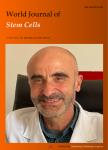In vitro induced pluripotency from urine-derived cells in porcine
作者机构:Department of SurgeryFaculty of Veterinary Medicine and Animal SciencesUniversity of São PauloPirassununga 13635-000São PauloBrazil Department of Pharmacology and BiotechnologyInstitute of BioscienceSão Paulo State UniversityBotucatu 18618-689São PauloBrazil Department of Veterinary MedicineFaculty of Animal Sciences and Food EngineeringUniversity of São PauloPirassununga 13635-000São PauloBrazil Embrapa Suínos e AvesEmpresa Brasileira de Pesquisa AgropecuáriaConcordia 89715-899Santa CatarinaBrazil Department of Animal SciencesFaculty of Animal Sciences and Food EngineeringUniversity of São PauloPirassununga 13635-000São PauloBrazil
出 版 物:《World Journal of Stem Cells》 (世界干细胞杂志(英文版)(电子版))
年 卷 期:2022年第14卷第3期
页 面:231-244页
核心收录:
学科分类:0831[工学-生物医学工程(可授工学、理学、医学学位)] 0710[理学-生物学] 0905[农学-畜牧学] 09[农学]
基 金:the São Paulo Research Foundation(FAPESP)-Brazil(financial support grants#2015/26818-5,#2013/08135-2,#2019/02811-2) Coordination of Superior Level Staff Improvement(CAPES 23038.006964/2014-43 and financial code 001) National Council for Scientific and Technological Development(CNPq 433133/2018-0)
主 题:Induced pluripotent stem cells Noninvasive Pluripotency Reprogramming Urine Porcine
摘 要:BACKGROUND The generation of induced pluripotent stem cells(iPSC)has been a game-changer in translational and regenerative medicine;however,their large-scale applicability is still hampered by the scarcity of accessible,safe,and reproducible *** porcine model is a large biomedical model that enables translational applications,including gene editing,long term in vivo and offspring analysis;therefore,suitable for both medicine and animal *** To reprogramme in vitro into pluripotency,and herein urine-derived cells(UDCs)were isolated from porcine *** The UDCs were reprogrammed in vitro using human or murine octamer-binding transcription factor 4(OCT4),SRY-box2(SOX2),Kruppel-like factor 4(KLF4),and C-MYC,and cultured with basic fibroblast growth factor(bFGF)*** characterize the putative porcine iPSCs three clonal lineages were submitted to immunocytochemistry for alkaline phosphatase(AP),OCT4,SOX2,NANOG,TRA181 and SSEA 1 *** transcripts related to the pluripotency(OCT4,SOX2 and NANOG)were analyzed via reverse transcription quantitative realtime polymerase chain reaction in different time points during the culture,and all three lineages formed embryoid bodies(EBs)when cultured in suspension without bFGF *** The UDCs were isolated from swine urine samples and when at passage 2 submitted to in vitro *** of putative iPSCs were obtained only from UDCs transduced with the murine factors(mOSKM),but not from human factors(hOSKM).Three clonal lineages were isolated and further cultured for at least 28 passages,all the lineages were positive for AP detection,the OCT4,SOX2,NANOG markers,albeit the immunocytochemical analysis also revealed heterogeneous phenotypic profiles among lineages and passages for NANOG and SSEA1,similar results were observed in the abundance of the endogenous transcripts related to pluripotent *** the clonal lineages when cultured in suspension without



